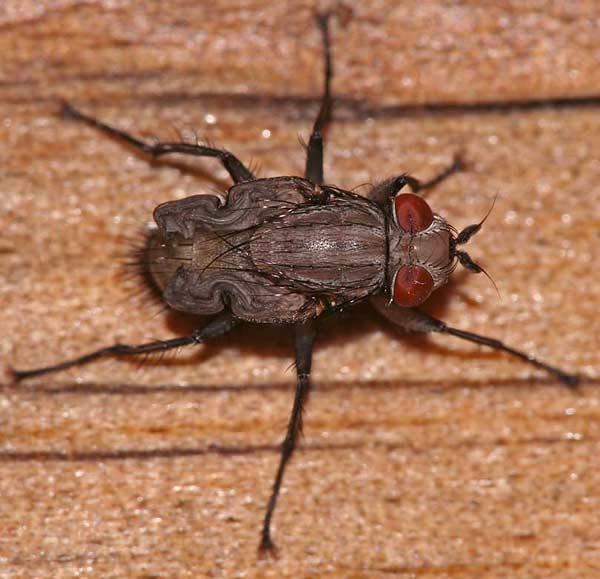Diptera.info :: Identification queries :: Diptera (adults)
Who is here? 1 guest(s)
|
Fly "without" wings
|
|
| Axel Steiner |
Posted on 05-03-2008 16:11
|
|
Member Location: Posts: 44 Joined: 05.03.08 |
Hello, I've found that fly at 24.07.2007 in Finnland (Aland-Islands). Without functionable wings it is major difficulty... Size like Musca domestica (perhaps it is Musca domestica?) (ca. 8 mm). Who can help? Axel Steiner attached the following image:  [38.82Kb] Edited by Axel Steiner on 05-03-2008 16:13 Best regards! Axel Steiner --------------------------------- Breckerfeld, Germany www.natur-in-nrw.de |
| Michael Ackland |
Posted on 05-03-2008 16:28
|
|
Member Location: Dorset UK Posts: 680 Joined: 23.02.08 |
This fly has only just emerged from the puparium, and has not yet pumped up it's wings |
|
|
|
| Xespok |
Posted on 05-03-2008 16:29
|
|
Member Location: Debrecen, Hungary Posts: 5550 Joined: 02.03.05 |
This fly is emerging. Had you waited another hour, you would have seen the fly pumping haemolymph into its wings thereby expanding it, and than the fly would have flown off. I can not comment on the species. Edited by Xespok on 05-03-2008 19:31 Gabor Keresztes Japan Wildlife Gallery Carpathian Basin Wildlife Gallery |
| Kahis |
Posted on 05-03-2008 18:56
|
|
Member Location: Helsinki, Finland Posts: 1999 Joined: 02.09.04 |
It is not Musca but some other muscoid fly (Muscidae or Anthomyiidae, it is difficult to tell with such a 'newborn' specimen)
Kahis |
| Andre |
Posted on 05-03-2008 19:54
|
|
Member Location: Tilburg, the Netherlands Posts: 2111 Joined: 18.07.04 |
Looks like Pollenia to me (Calliphoridae). I remember these youngborn crawling about frequently in offices and such... |
| Axel Steiner |
Posted on 05-03-2008 20:39
|
|
Member Location: Posts: 44 Joined: 05.03.08 |
Perhaps more pictures can help...
Axel Steiner attached the following image:  [21.35Kb] Edited by Axel Steiner on 05-03-2008 22:47 Best regards! Axel Steiner --------------------------------- Breckerfeld, Germany www.natur-in-nrw.de |
| Axel Steiner |
Posted on 05-03-2008 20:42
|
|
Member Location: Posts: 44 Joined: 05.03.08 |
...and another one.
Axel Steiner attached the following image:  [28.72Kb] Best regards! Axel Steiner --------------------------------- Breckerfeld, Germany www.natur-in-nrw.de |
| crex |
Posted on 05-03-2008 22:05
|
|
Member Location: Sweden Posts: 1996 Joined: 22.05.06 |
The feet are big. Sarcophagidae? |
|
|
|
| Kahis |
Posted on 05-03-2008 22:25
|
|
Member Location: Helsinki, Finland Posts: 1999 Joined: 02.09.04 |
I doubt it is Pollenia - no pale curly hairs are seen. I suspect crex is right (and thus I am wrong  ) )
Kahis |
| Axel Steiner |
Posted on 06-03-2008 06:18
|
|
Member Location: Posts: 44 Joined: 05.03.08 |
Thanks for explanatory notes and the determination to all of you. I think Sarcophagidae is a good idea :-) Best regards! Axel Steiner --------------------------------- Breckerfeld, Germany www.natur-in-nrw.de |
| ChrisR |
Posted on 06-03-2008 22:44
|
|
Administrator Location: Reading, England Posts: 7699 Joined: 12.07.04 |
The red eyes and prominent bristles suggest a sarcophagid. I have heard that some flies can remain teneral for quite a long time - up to 48 hours I think. Can't remember the source for that though. |
| Jump to Forum: |















